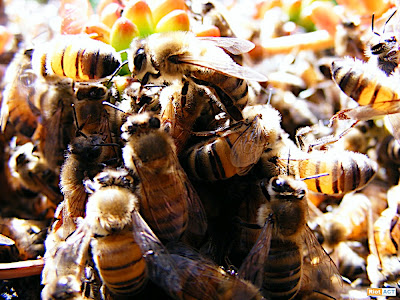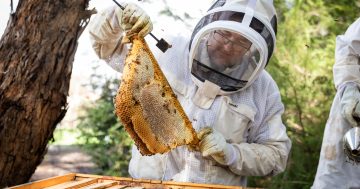[First filed: October 13, 2008 @ 16:04]

In the thread about Johnboy’s question about bees t’other day, most people seemed to be unaware that swarming season is starting.
Bees swarm in Spring, when they realise they’ve become over-resourced, and feel the need to breed.
So they gorge themselves on honey, and go hunting for new places to start hives.
For this reason, most actual beekeepers would prefer to split up their own hives before this point of Spring, but if you’re one of those people who just has huge trees full of hollows around the place, you probably have a natural hive or two, and can expect something similar to this in the near future.
(Or those of you with large trees in your suburb might suddenly notice the air is thick with bees, and there are clumps of bees haning from them)
Hives will swarm once the old queen has produced enough bees and honey to sustain the current hive, and also fission the hive into a new colony.
(Slideshow and more below)
So the workers start grooming a new queen bee (or two, just to be safe), while the old queen takes her share of the hive, and they kind of just ‘fall out’ of the tree onto something nearby.
Like your washing line, a nearby shrub, or the back fence.
Then, that swarm send out some scouts, while the rest of the workers all play stacks-on with the Queen, to defend her if needed.
Thats what you see as the big piles of bees later on in the slideshow.
Occasionally a hive might send out two swarms, if its grown especially big over Winter and Spring.
And Floriade is essentially just one great big festival for bees, where they can make as much honey as they feel like.
If you see a beehive swarming
The good news is, if they’re swarming then you’re prettymuch safe from being stung.
Some of these photos are from as close as about 10cm away from the edge of the swarm.
The bees have other things to be interested instead of stinging you, like defending their queen, finding a new home, and are so full of honey that they don’t much care what you do to them.
(Think about how little you really care about on Christmas Day after a big feed, and you can see why the bees don’t want to do much except find a safe place to rest).
NOTE: This doesn’t mean you can kick a swarm, or stick your fist into it and pluck out their Queen, or anything. They’re just less aggressive than usual.
The bad news is that when they’re swarming and find a place to settle on a tree, thats only two thirds of the hive, the others are out scouting for safe places to set up.
This could include hollows in gum trees, or if you’re unlucky, a hole in your wall.
Once they find a good place, those scouts come back to the Queen and her swarm, and then they all up and fly away to their new home.
What to do if you don’t want it
If you find a swarm of bees in a place you don’t want, or just want to get rid of them before they set up home insde your walls, you should give these people a call.
We were in the process of calling the Beekeepers’ Society when the swarms all flew away across the suburb, so if they settled in your backyard or house, I’m sorry.
List of ACT Beekeepers’ Society Swarm Handlers:
http://www.actbeekeepers.asn.au/swarmcollectors/index.htm
For further information, ACT Beekeepers Society Homepage:
http://www.actbeekeepers.asn.au/common/home.htm
Note: The Beekeepers’ Society may charge a small fee for swarm removal, but they will remove the entire swarm intact, and its still cheaper than getting a pest controller in to poison and kill the swarm.
(Check with the swarm handler what their fee will be)



















